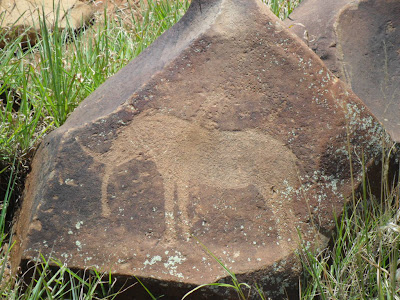Who knew that there was stuff to do in Kimberley! I mean, I’ve visited the Big Hole, I’ve pet baby lions and I’ve gone to the Hospitality House (a hotel that doubles as a bar/ late night hang out for white people… I didn’t like it much). I thought I had done it all.
 |
| Just 10km outside of Kimberley we found rock art engravings. The body of water seen here is called a pan. It fills during the rainy season and is a necessary source of water for grazing farm animals. |
The Wildebeest Kuil farm is owned by two San groups, the !Xun and the Khwe, who originate from modern day Namibia. During the later half of the twentieth century, they were employees of the South African Defense Force and in 1990 (after Namibia won its independence from South Africa) the SADF decided to move members of these two San groups to Schmidstdrift, a town west of Kimberley. In the early 2000’s however, Tswana farmers who had previously owned the land before the SADF moved the San peoples won the rights to the land and the San were forced to relocate. The two San groups pooled together all of their money and purchased Wildebeest Kuil and some adjoining farms.
 |
| This is an eland. |
Today these two groups live in Platfontein, a community that lies just outside of Kimberley. Platfontein is one of the poorest areas near Kimberley and currently has an unemployment rate of 97-percent. We have worked in the Primary School in Platfontein and it was one of the harder schools to work in because the two San groups do not trust each other. In fact, the school acts as the dividing line between the two San groups. As a result, students feel uncomfortable discussing and sharing stories with the other group.
The rock engravings found at the Wildebeest Kuil Rock Art Center are one attempt that elders of the !Xun and the Khwe have made to preserve links to their cultural inheritance. But our guide informed us that it seems as if the Khoi-San culture in Platfontein is doomed to die out; only a few elders still know the oral stories of the San culture and can play traditional Khoi-San instruments and many of the youth are only interested in cultural endeavors if there is money in it.
 |
| According to our guide, rock engravings that only show half of an animal represent that animal entering or exiting the spirit world. |
After checking out the rock engravings we continued on down the road until we saw this sign:
 |
| Sketchy... no? |
We had reached the Nooitgedacht Glacial Pavings. These glacial pavings are a geologic feature (yay geology!). About 300 million years ago, there was a volcano located here (most of the rock here and at the Wildebeest Kuil farm was a volcanic rock called andesite). During an ice age large glaciers moved across the bedrock smoothing it and leaving striations on it.
 |
| To the right of my flip flop is a large rock embedded in the paving. It is likely that a portion of this rock was shaved off by the glaciers. |
 |
| Striations on the glacial pavement. Notice that there are more engravings here. These engravings are thought to have been made about 1500 years ago. |
To end our day, David graciously treated us to ice cream floats (he knew about our experiment to spend only R1000 in February)! I just ate the ices cream, but it was still a great end to a fun (and very hot) day.
 |
| Trevor and I on one of the glacial pavings. |

No comments:
Post a Comment